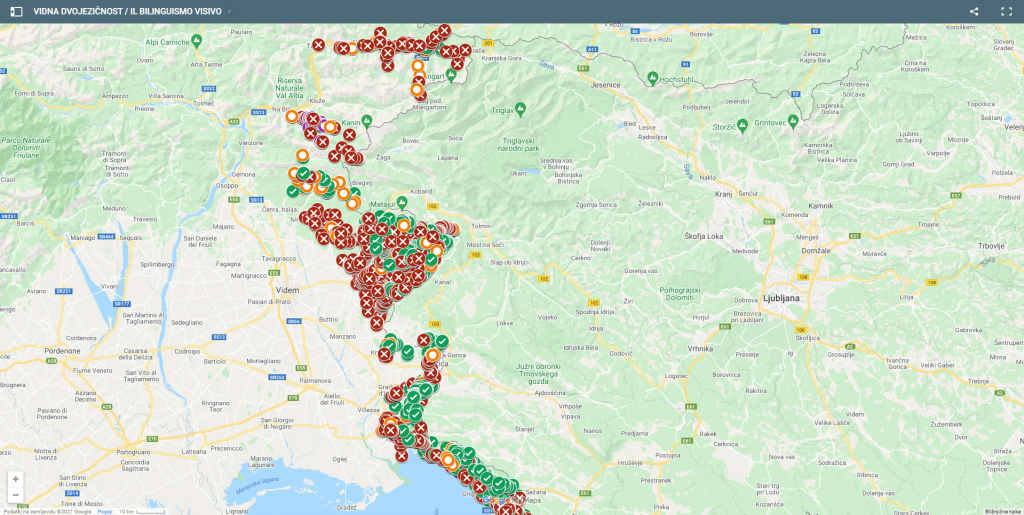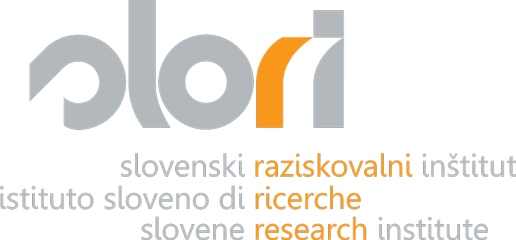Client: Friuli Venezia Giulia Regional Council
Implementing subject: SLORI
Responsible for research: Zaira Vidau
Performance period: March-October 2021


The digital map on visual bilingualism presents 4505 photos of public signs in the provinces of Trieste, Gorizia and Udine, which were collected for the purposes of the Verification of the degree of implementation of the provisions pursuant to art. 10 of the Protection Law no. 38/2001 on public signs and toponymy within the framework of the Third regional conference on the protection of the Slovene linguistic minority.
Article 10 of Law no. 38 of 23 February 2001, no. 38 – Rules for the protection of the Slovene linguistic minority in the Friuli Venezia Giulia region reads as follows: ‘By decree of the President of the Regional Council, on the basis of the proposal of the Committee and after hearing the interested bodies, the municipalities, the fractions of municipalities, the localities and the bodies in which the use of the Slovene language is provided for in addition to the Italian language in the signs of public offices, in the official paper and, in general, in all public signs, as well as in the banners, are identified on the basis of the table in article 4. The same provisions shall also apply to toponymic indications and road signs”.
The area subject to visual bilingualism was formally determined in the period from 2008 to 2012, following a procedure managed by the Joint Institutional Committee for the Problems of the Slovene Minority (hereinafter referred to as the Joint Committee), which drew up the list of municipalities, provinces, mountain communities and service concessionaires obliged to apply the provisions of Art. 10 of the Protection Law no. 38/2001. The aforementioned entities were asked to officially express their opinion on their inclusion in the scope of application of the law; each interested party sent the Joint Committee a formal request for inclusion with possible clarifications and limitations. The Joint Committee then forwarded the table of entities and public service concessionaires, with the relevant documentation attached, to the President of the Autonomous Region of FVG, who adopted the following five implementing decrees (D.P. Reg. FVG)
– Decree of the President of the autonomous region Friuli Venezia Giulia 18 December 2008, no. 346;
– Decree of the President of the Autonomous Region Friuli Venezia Giulia 31 December 2008, no. 362;
– Decree of the President of the Autonomous Region Friuli Venezia Giulia 27 October 2009, no. 300;
– Decree of the President of the Autonomous Region of Friuli Venezia Giulia No 70 of 21 March 2012;
– Decree of the President of the Autonomous Region of Friuli Venezia Giulia No 71 of 21 March 2012.
The further D.P. Reg. FVG 2 December 2013, no. 229 identifies the public service concessionary entities, which are obliged to apply the protection measures pursuant to art. 10 of the Protection Law no. 38/2001 in the identified and delimited territorial area.
We photographed the public signs on the territory of the 32 municipalities where the protection regulations apply. We took into consideration:
– 20 municipalities in their entirety: Duino-Aurisina/Devin – Nabrežina, San Dorligo della Valle/Dolina, Monrupino/Repentabor and Sgonico/Zgonik in the province of Trieste; Doberdò del Lago/Doberdob, Ronchi dei Legionari/Ronke, Savogna d’Isonzo/ Sovodnje ob Soči and San Floriano del Collio/ Števerjan in the province of Gorizia; Attimis/Ahten, Lusevera/Bardo, Drenchia/Dreka, Grimacco/Grmek, Malborghetto-Valbruna/Naborjet-Ovčja vas, Pulfero/Podbonesec, Resia/Rezija, San Leonardo/Sv. Lenart, Savogna/Sovodnja, Stregna/ Srednje, Taipana/Tipana and Tarvisio/Trbiž in the province of Udine;
– 7 municipalities that have included in the scope of visual bilingualism only certain hamlets or localities: Muggia and Trieste in the province of Trieste; Cormons, Gorizia and Sagrado in the province of Gorizia; Faedis and Nimis in the province of Udine;
– 5 municipalities, which are currently excluded from the scope of application of visual bilingualism, although they are included in the table of municipalities that fall within the perimeter territory for the application of Protection Law 38/2001: Tržič/Monfalcone in the province of Gorizia; Čedad/Cividale, Prepotto, Špeter/San Pietro al Natisone and Torreano in the province of Udine.
We photographed public signs of various types, grouping them into ten categories:
- direction signs
- start and end town centre signs
- odonyms
- signs for the start of municipal and provincial territory
- signs for points of public interest and useful services
- points of public interest and useful services
- prohibition, restriction, danger and ordinance signs
- tourist signs
- signs on roadside recycling bins
- signs at bus stops: timetables and rules for using the service, stop names, stop signs and signs on ticket vending machines.
